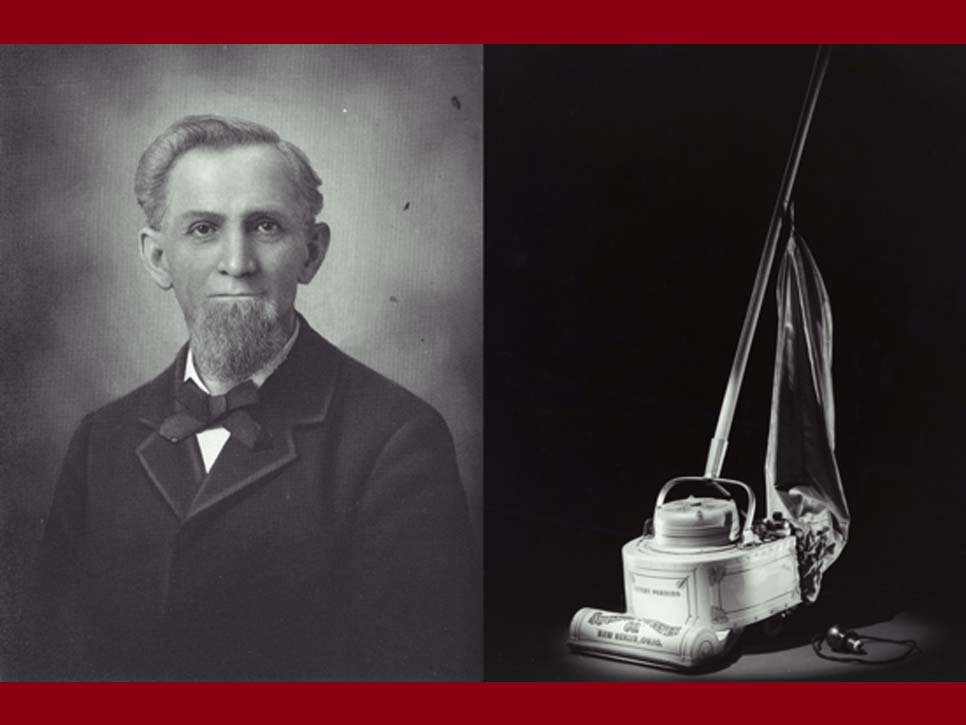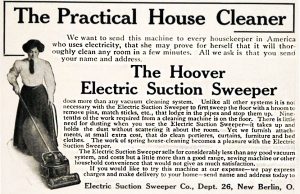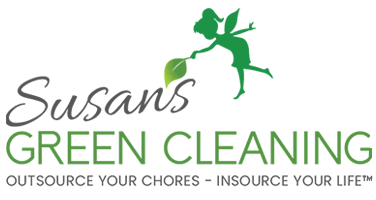
The Vacuum Cleaner
If you have carpets, vacuuming is an important part of keeping your home dust-free. Below is a history of how vacuum cleaners evolved into the sophisticated machines we use today.
History of the Vacuum Cleaner
Vacuum cleaners were invented in the early 1900s. They evolved from non-electric bellows that could suck in air to a bag to a fully electric machine that could create suction with the intake of air and rotate brushes to sweep a carpet or floor.

Hoover’s company grew and eventually called their vacuum cleaners Hoovers. Hoovers had competition but were so established that they became THE worldwide household cleaning brand. (To this day, to vacuum in England is to “hoover” your rug, regardless of what brand of unit you are using.)
The Hoover Company employed many workers and had such a large manufacturing plant that the area was dubbed Hooverville. A large smokestack in the vicinity was painted “Hooverville.”
Basically vacuums are separated into two categories: canisters and uprights. Canisters are just that; a cannister which houses the motor and collects the dirt with hoses and attachments. Uprights collect debris with the use of bags and a rotating brush roll to sweep the floor surface. An upright vacuum cleaner is specifically for carpets, although some do come with attachments to accommodate light dusting and hoses to reach areas like ceilings, under tables, and furniture surfaces. Canisters are best used for what is known as accessory cleaning for everything but carpets. Some canisters do come with a power brush head to clean carpets but not as easily as or as efficiently as as uprights. Their strongest suit is straight suction cleaning. Upright vacuums create a seal on carpets that help vibrate dirt from the base of the carpet, not just a surface clean.
Another kind of vacuum cleaner is the shop vac. Shop vacs are great for nasty jobs like sucking up water, overflows, messes in vehicles, garages, and sheds. They are easy to clean and are not made to filter particulates like indoor machines.
A variation of the shop vac is a type of cleaner that filters with water, such as Rainbow vacuum cleaners. The main concern with water-containing vacuums is that they can harbor mildew and mold because the moisture remains for some time within the machine, even when the water is emptied. When the machine is turned on, mold spores exhaust into the room, causing allergic responses.
There is another kind of vacuum cleaner that we haven’t yet mentioned: a central unit. Central unit vacuums are also known as “built-ins”. They are installed directly into the house with the idea that all exhausted air can vent outside instead of inside. The main unit can be placed in a basement, garage, or outdoor covered space. Central units have the largest motors and draw dirt through pvc pipes inside the walls connected to long hoses between 25 and 50 feet in length. There are a few drawbacks about central units. They are:
-
- Susceptible to breaks in both the hoses and the pipes
-
- Not usually as powerful as upright vacuums, even though they have larger motors, because they must suck dirt for longer distances
-
- Difficult to restore suction when clogs occurs in the wall space
Ugly fact: Do you know that carpets can hold seven times their weight in dirt? It’s true.
Take out an old carpet and you will quickly see the evidence. The right vacuum cleaner makes all the difference.
Filtration
A word about the exhaust: whenever air comes into the unit as suction or airflow, air has to escape as exhaust. To ensure that the air isn’t sending airborne particulates into your living space, filters are necessary. Just running a vacuum over the carpet can stir up allergens.
There are different approaches to filtration.
Good: Form fitting filters are good, easily rinsed out, and can be reused efficiently.
Better: Standard filters have better porosity to allow higher air flow (more suction) until they are clogged and need to be replaced. If filters aren’t replaced, then clogged filters will overheat the motor.
Best: High filtration filters such as Filtrete and HEPA (High Efficiency Particulate Arresters) filter out respirable particulates without reducing the air flow or suction.
Susan’s Green Cleaning uses exclusively Miele vacuums, the top of the line vacuum in the United States and Europe, which remove 99.97% of allergens in the air through the use of HEPA filters which are absolutely fantastic at removing dust mites, pet dander, and a dozen of other allergens that cause cold and flu-like symptoms as well as breathing problems. Cleaner air, cleaner breathing.
Book a thorough cleaning here.


